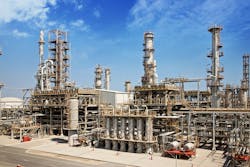Qatar Petroleum integrates Mesaieed refining, petrochemical operations
Qatar Petroleum (QP) has completed integration of subsidiary SEEF Ltd.’s linear alkyl benzene (LAB) plant and petrochemical operations into QP’s 137,000-b/d refinery in Mesaieed Industrial City (MIC), about 40 km south of Doha, Qatar.
As of Apr. 18—ahead of its original deadline of late second-quarter 2020—QP Operations (Refining) achieved full integration of and is now fully operating SEEF’s petrochemical plants, which are located adjacent to QP’s MIC refinery, QP said.
Part of QP’s ongoing effort to strengthen its competitive position in the downstream sector by maximizing synergies and resources of both companies, integration of SEEF’s operations will not alter SEEF’s existing brand, which will remain fully in place, QP said.
Further details regarding completed integration of the refining and petrochemical sites were not disclosed.
QP took sole ownership of SEEF in late 2018 following its acquisition of United Development Co.’s 20% interest in the petrochemical company, according to QP’s latest annual report for the year ending 2018.
Alongside 100,000 tonnes/year of LAB, SEEF’s MIC complex also produces 80,000 tpy of normal paraffin, 36,000 tpy of benzene, and 3,500 tpy of heavy alkyl benzene (heavy alkylate) as by-product, according to QP and SEEF’s websites.
In 2018, QP also completed preliminary front-end engineering design (pre-FEED) activities for a proposed upgrade of the MIC refinery, the operator said in its annual report.
Designed to improve the refinery’s gasoline production to Euro 5-quality specifications from Euro 3 standards, the planned upgrading project will involve installation of a new residue fluid catalytic cracker (RFCC) and light-gasoline hydrotreating unit.
In its 2018 annual report, QP said it expected to progress into FEED activities for the proposed refinery upgrade by early 2020.
The MIC refinery processes a feedstock consisting mainly of crude oil and condensate from Dukhan field, as well as condensate from North field.
About the Author
Robert Brelsford
Downstream Editor
Robert Brelsford joined Oil & Gas Journal in October 2013 as downstream technology editor after 8 years as a crude oil price and news reporter on spot crude transactions at the US Gulf Coast, West Coast, Canadian, and Latin American markets. He holds a BA (2000) in English from Rice University and an MS (2003) in education and social policy from Northwestern University.

